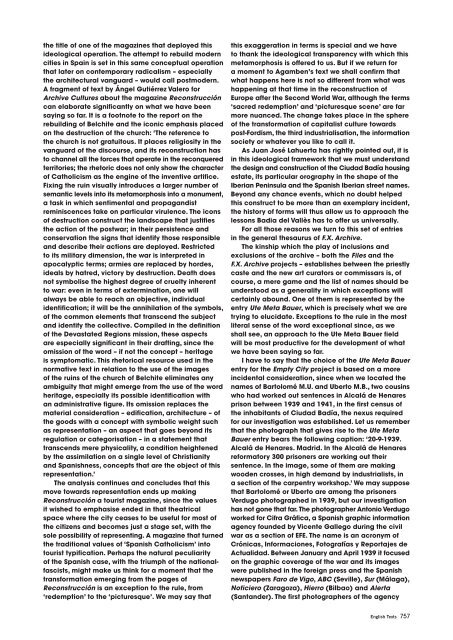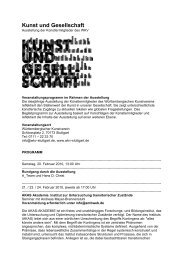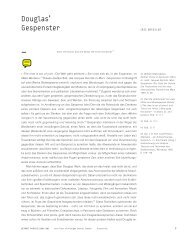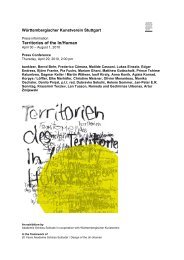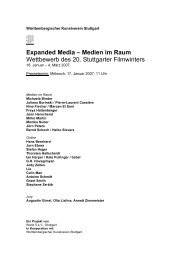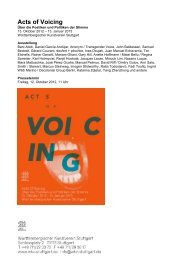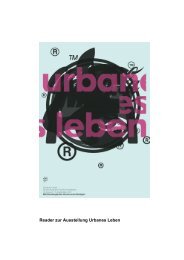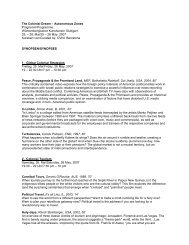English Texts
English Texts
English Texts
You also want an ePaper? Increase the reach of your titles
YUMPU automatically turns print PDFs into web optimized ePapers that Google loves.
the title of one of the magazines that deployed this<br />
ideological operation. The attempt to rebuild modern<br />
cities in Spain is set in this same conceptual operation<br />
that later on contemporary radicalism – especially<br />
the architectural vanguard – would call postmodern.<br />
A fragment of text by Ángel Gutiérrez Valero for<br />
Archive Cultures about the magazine Reconstrucción<br />
can elaborate significantly on what we have been<br />
saying so far. It is a footnote to the report on the<br />
rebuilding of Belchite and the iconic emphasis placed<br />
on the destruction of the church: ‘The reference to<br />
the church is not gratuitous. It places religiosity in the<br />
vanguard of the discourse, and its reconstruction has<br />
to channel all the forces that operate in the reconquered<br />
territories; the rhetoric does not only show the character<br />
of Catholicism as the engine of the inventive artifice.<br />
Fixing the ruin visually introduces a larger number of<br />
semantic levels into its metamorphosis into a monument,<br />
a task in which sentimental and propagandist<br />
reminiscences take on particular virulence. The icons<br />
of destruction construct the landscape that justifies<br />
the action of the postwar; in their persistence and<br />
conservation the signs that identify those responsible<br />
and describe their actions are deployed. Restricted<br />
to its military dimension, the war is interpreted in<br />
apocalyptic terms; armies are replaced by hordes,<br />
ideals by hatred, victory by destruction. Death does<br />
not symbolise the highest degree of cruelty inherent<br />
to war: even in terms of extermination, one will<br />
always be able to reach an objective, individual<br />
identification; it will be the annihilation of the symbols,<br />
of the common elements that transcend the subject<br />
and identify the collective. Compiled in the definition<br />
of the Devastated Regions mission, these aspects<br />
are especially significant in their drafting, since the<br />
omission of the word – if not the concept – heritage<br />
is symptomatic. This rhetorical resource used in the<br />
normative text in relation to the use of the images<br />
of the ruins of the church of Belchite eliminates any<br />
ambiguity that might emerge from the use of the word<br />
heritage, especially its possible identification with<br />
an administrative figure. Its omission replaces the<br />
material consideration – edification, architecture – of<br />
the goods with a concept with symbolic weight such<br />
as representation – an aspect that goes beyond its<br />
regulation or categorisation – in a statement that<br />
transcends mere physicality, a condition heightened<br />
by the assimilation on a single level of Christianity<br />
and Spanishness, concepts that are the object of this<br />
representation.’<br />
The analysis continues and concludes that this<br />
move towards representation ends up making<br />
Reconstrucción a tourist magazine, since the values<br />
it wished to emphasise ended in that theatrical<br />
space where the city ceases to be useful for most of<br />
the citizens and becomes just a stage set, with the<br />
sole possibility of representing. A magazine that turned<br />
the traditional values of ‘Spanish Catholicism’ into<br />
tourist typification. Perhaps the natural peculiarity<br />
of the Spanish case, with the triumph of the nationalfascists,<br />
might make us think for a moment that the<br />
transformation emerging from the pages of<br />
Reconstrucción is an exception to the rule, from<br />
‘redemption’ to the ‘picturesque’. We may say that<br />
this exaggeration in terms is special and we have<br />
to thank the ideological transparency with which this<br />
metamorphosis is offered to us. But if we return for<br />
a moment to Agamben’s text we shall confirm that<br />
what happens here is not so different from what was<br />
happening at that time in the reconstruction of<br />
Europe after the Second World War, although the terms<br />
‘sacred redemption’ and ‘picturesque scene’ are far<br />
more nuanced. The change takes place in the sphere<br />
of the transformation of capitalist culture towards<br />
post-Fordism, the third industrialisation, the information<br />
society or whatever you like to call it.<br />
As Juan José Lahuerta has rightly pointed out, it is<br />
in this ideological framework that we must understand<br />
the design and construction of the Ciudad Badía housing<br />
estate, its particular orography in the shape of the<br />
Iberian Peninsula and the Spanish Iberian street names.<br />
Beyond any chance events, which no doubt helped<br />
this construct to be more than an exemplary incident,<br />
the history of forms will thus allow us to approach the<br />
lessons Badia del Vallès has to offer us universally.<br />
For all those reasons we turn to this set of entries<br />
in the general thesaurus of F.X. Archive.<br />
The kinship which the play of inclusions and<br />
exclusions of the archive – both the Files and the<br />
F.X. Archive projects – establishes between the priestly<br />
caste and the new art curators or commissars is, of<br />
course, a mere game and the list of names should be<br />
understood as a generality in which exceptions will<br />
certainly abound. One of them is represented by the<br />
entry Ute Meta Bauer, which is precisely what we are<br />
trying to elucidate. Exceptions to the rule in the most<br />
literal sense of the word exceptional since, as we<br />
shall see, an approach to the Ute Meta Bauer field<br />
will be most productive for the development of what<br />
we have been saying so far.<br />
I have to say that the choice of the Ute Meta Bauer<br />
entry for the Empty City project is based on a more<br />
incidental consideration, since when we located the<br />
names of Bartolomé M.U. and Uberto M.B., two cousins<br />
who had worked out sentences in Alcalá de Henares<br />
prison between 1939 and 1941, in the first census of<br />
the inhabitants of Ciudad Badía, the nexus required<br />
for our investigation was established. Let us remember<br />
that the photograph that gives rise to the Ute Meta<br />
Bauer entry bears the following caption: ‘20-9-1939.<br />
Alcalá de Henares. Madrid. In the Alcalá de Henares<br />
reformatory 300 prisoners are working out their<br />
sentence. In the image, some of them are making<br />
wooden crosses, in high demand by industrialists, in<br />
a section of the carpentry workshop.’ We may suppose<br />
that Bartolomé or Uberto are among the prisoners<br />
Verdugo photographed in 1939, but our investigation<br />
has not gone that far. The photographer Antonio Verdugo<br />
worked for Cifra Gráfica, a Spanish graphic information<br />
agency founded by Vicente Gallego during the civil<br />
war as a section of EFE. The name is an acronym of<br />
Crónicas, Informaciones, Fotografías y Reportajes de<br />
Actualidad. Between January and April 1939 it focused<br />
on the graphic coverage of the war and its images<br />
were published in the foreign press and the Spanish<br />
newspapers Faro de Vigo, ABC (Seville), Sur (Málaga),<br />
Noticiero (Zaragoza), Hierro (Bilbao) and Alerta<br />
(Santander). The first photographers of the agency<br />
<strong>English</strong> <strong>Texts</strong> 757


